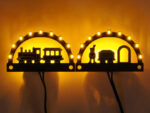Infrared: Block signal mode
Description of the Block signal mode with our IR System. You need additional Track Contacts and a Feedback module. Input A set the signals to red, input B set the signal to green. The last contact (4) has a special function. He releases the block signal again. If your block signal layout is a circle, you can remove the last contact. Therefore you have to connect 1A with 3B….


 Deutsch
Deutsch


